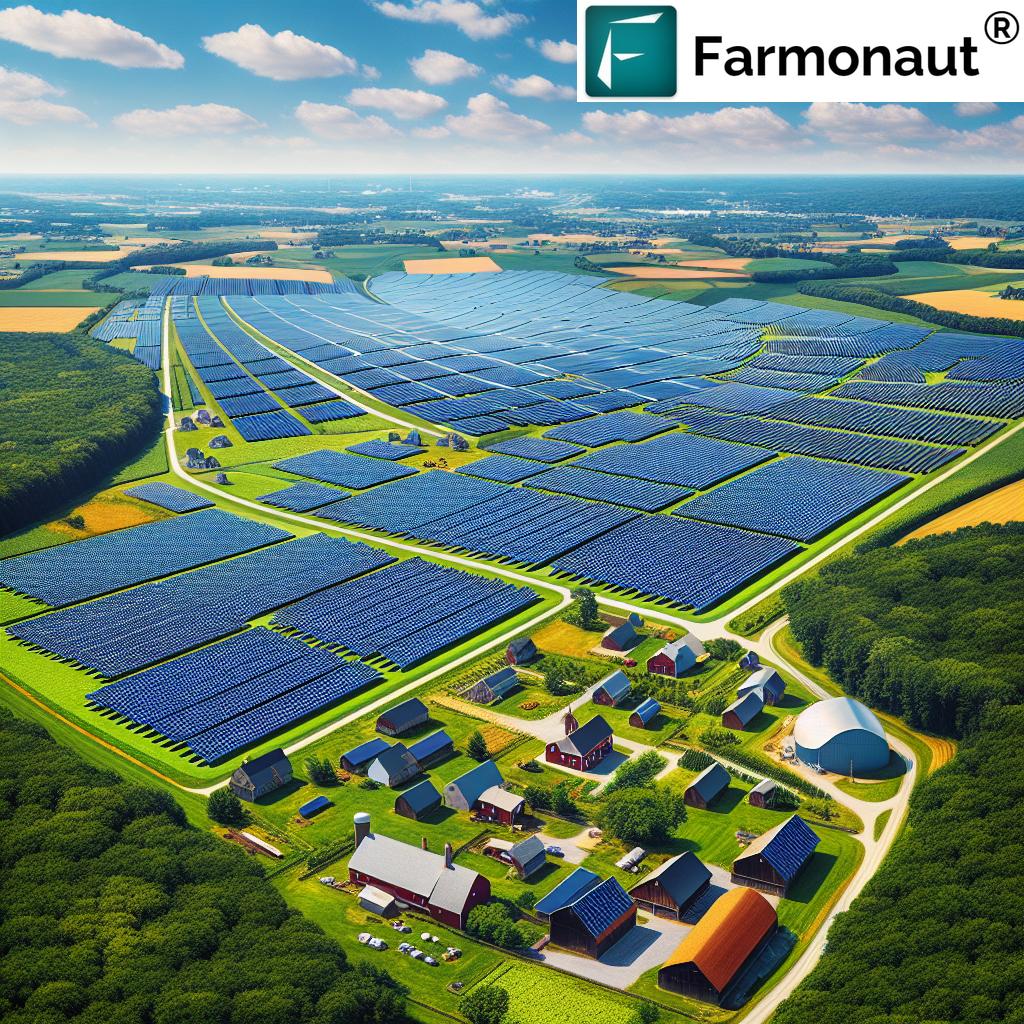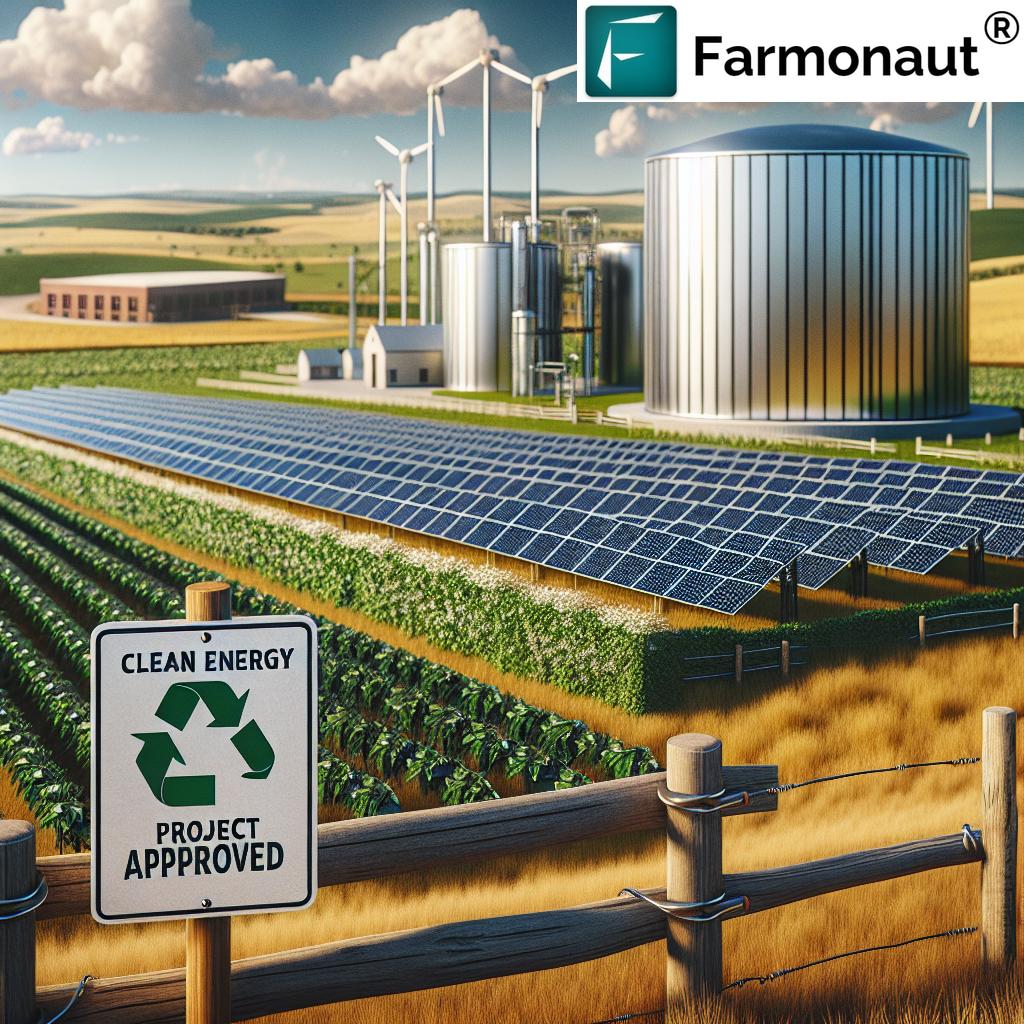Solar Energy Maryland: 5 Key Impacts of New Renewable Legislation
“In 2023, Maryland’s new renewable laws aim to increase solar capacity by 50% within the next decade.”
“Over 30,000 rural acres in Maryland could be repurposed for solar projects under recent legislative changes.”
- Introduction: Solar Energy Maryland
- Understanding Maryland’s Renewable Energy Legislation
- Key Statistics: Rural Land & Solar Projects
- Comparative Impact Table: Before vs After Renewable Legislation
- Five Key Impacts of Maryland’s Renewable Legislation
- Farmonaut: Precision Agriculture & Sustainability Tools
- FAQ: Frequently Asked Questions
- Conclusion: Charting a Sustainable Path Forward
Introduction: Solar Energy Maryland
At the very forefront of clean energy transformation, Maryland has established itself as a state with ambitious renewable energy goals. As solar energy becomes more accessible and integral to meeting our energy demand, new renewable energy legislation — specifically HB 1036/SB 931, known as the Renewable Energy Certainty Act — is reshaping how solar projects are developed, approved, and managed throughout Maryland. This is a pivotal moment: the way we adapt today will determine the future of our rural communities, agricultural lands, and our overall sustainability.
With a focus on solar energy Maryland, let us explore the sweeping impacts that this legislative change brings — from a surge in solar farm development and transformation of rural land, to the evolving relationship between agricultural productivity, local community priorities, and state-level clean energy ambitions.


Why Is Solar Energy Rising in Maryland?
The increasing affordability of solar technology, coupled with government incentives and the urgent need to transition away from fossil fuels, positions Maryland as a leader in the US for renewable deployment. Yet, this growth brings complex challenges: notably, how to balance the expansion of solar with the preservation of farmland and the protection of local interests in rural communities.
The recently passed Renewable Energy Certainty Act aims to accelerate solar energy Maryland deployment by removing barriers that have previously slowed project approval, while controversially shifting certain control from local to state-level authorities. Let us closely examine what this means for stakeholders across our state.
Understanding Maryland’s Renewable Energy Legislation
The Renewable Energy Certainty Act (HB 1036/SB 931) was introduced to help Maryland achieve its clean energy goals by streamlining the approval process for solar projects and energy storage projects Maryland-wide. Yet, it’s important to understand the full scope and implications of this sweeping bill as it moves through legislative and community review.
Core Objectives of the Renewable Energy Certainty Act
- Accelerate the development of solar and energy storage projects across the state.
- Streamline and centralize the site approval process under the Public Service Commission, limiting the influence of local government control solar siting.
- Remove existing barriers to solar deployment on both active farmland and protected agricultural land.
- Enable large-scale renewable projects to compete and support Maryland’s statewide sustainability and clean energy mandates.
While supporters of the plan emphasize the need to streamline the process and meet climate targets, local leaders in rural communities have voiced deep concern: that this legislation “opens the floodgates for unlimited solar farm development,” removes vital local checks, and may lead to a significant loss in farmland for a generation or more.
Key projected impacts include the repurposing of tens of thousands of acres in counties such as Caroline, Garrett, and Allegany, and a dramatic increase in the size and scope of individual solar projects such as Cherrywood Solar I and Jade Meadow III.
Key Statistics: Rural Land & Solar Projects
- Maryland’s 2030 Climate Target: Achieve 50% more solar energy capacity within the next decade.
- Projected Rural Land Use: Over 30,000 acres of Maryland farmland could be repurposed for solar projects.
-
Notable Large-Scale Projects:
- Cherrywood Solar I (Caroline County): 1,059 acres
- Jade Meadow III (Garrett and Allegany counties): 1,852 acres
- Solar Farm Lifespan: The typical project operates for 30 years, with at least 10 more years needed to return soil to productive agricultural use after decommissioning.
Comparative Impact Table on Rural Land and Agriculture – Before vs After Legislation
To truly grasp the magnitude of this change, let us compare the expected impacts on key dimensions of solar energy Maryland, farmland use, and local economic activity.
| Impact Area | Estimated Value Before Legislation |
Estimated Value After Legislation |
|---|---|---|
| Land Allocated to Solar Farms (acres) | ~8,500 acres statewide | 30,000+ acres statewide |
| Estimated Renewable Energy Output | ~2,100 MW | 3,000+ MW |
| Farmland Affected (active production lost) | Minimal loss; projects limited in scale | Significant loss; large segments of rural farmland repurposed |
| Number of Solar Projects | Moderate (annual additions ~12-15 projects) | Major increase; large-scale projects fast-tracked |
| Estimated Local Revenue | Stable; based on traditional ag economy | Varies; lease payments to landowners/changes to tax base |
| Agricultural Productivity | High; land actively farmed | Potential decline; production removed for 30+ years |
Five Key Impacts of Maryland’s Renewable Legislation
1. Surge in Solar Farm Development and Land Use
Perhaps the most immediate and visible shift is the rapid growth in solar farm development—especially on rural lands and previously protected agricultural areas. The removal of local-level restrictions and the new fast-tracked approval process for solar projects mean that developers can pursue larger projects covering thousands of acres at a time.
- Large projects like Cherrywood Solar I and Jade Meadow III represent a new scale: hundreds to thousands of acres in a single county.
- State-level oversight encourages developers to seek out inexpensive, rural farmland, often leading to the attraction of rural counties like Caroline, Garrett, and Allegany.
- Experts estimate 30,000+ rural acres could soon host solar energy Maryland infrastructures.
This expansion is crucial for achieving clean energy goals Maryland, yet it fundamentally alters the landscape and rural community character, posing real questions about long-term impact on agriculture and local economies.
2. Streamlining the Approval Process for Solar Projects
The Renewable Energy Certainty Act significantly changes the approval process for solar projects in Maryland. The state’s Public Service Commission now has greater autonomy to approve sites, with less requirement for local government sign-off.
- Accelerated timelines: The process is designed to enable projects to move from proposal to construction much more quickly.
- Removal of local-level barriers: Streamlined, standardized criteria for solar project approval means fewer obstacles for developers looking to meet state energy targets.
- Potential downsides: This shift can sideline local voice and the ability to restrict solar projects on protected or valuable agricultural lands, leading to tension in affected counties.
Supporters believe this fast-tracking is essential for removing barriers to clean and renewable technology deployment. However, rural leaders fear it tips the scales in favor of developers at the expense of farming communities and their long-term interests.
Streamlined Siting: What Does It Mean For Rural Counties?
- Real Example: Public hearings for solar projects in Garrett and Allegany now focus more on technical compliance than community consensus.
- Scale of Development: Projects are no longer capped by county-level zoning, resulting in larger, contiguous solar farms that reshape the visual and functional landscape.
3. Impact of Solar Farms on Agriculture and Rural Communities
One of the most contentious discussions involves the impact of solar farms on agriculture. While some landowners may welcome the economic benefits—such as lease payments and stable income—others in the agricultural sector warn of irreversible damage:
- Loss of active farmland: Every acre of agricultural land removed from production can affect the surrounding interdependent industries, from grain milling to local food supply systems.
- Long-term soil disruption: Experts estimate decommissioned solar farms require at least a decade before the soil can return to its original agricultural productivity.
- Economic ripple effect: The loss of each acre has an estimated sevenfold multiplier on local economies, reducing farm income, jobs, and downstream industry activity.
- Community identity: Rural communities often define themselves by agricultural production. A large-scale shift toward solar can alter the cultural landscape, social bonds, and the overall sense of place.
Protected Farmland Solar Development: A Debate on Sustainability
The legislative change directly impacts protected farmland solar development, an issue dividing state policymakers and rural leaders. Some argue that shared use—allowing solar energy infrastructure while maintaining perimeter agriculture—could balance the need for renewable energy with preservation. Others, however, highlight the risk of permanent significant loss of agricultural land, especially if local governments have limited ability to restrict or guide project siting.
“In 2023, Maryland’s new renewable laws aim to increase solar capacity by 50% within the next decade.”
“Over 30,000 rural acres in Maryland could be repurposed for solar projects under recent legislative changes.”
What Happens to Farmland After Solar Projects End?
- After 30 years of operation, solar projects are decommissioned, but the soil recovery process to restore agricultural productivity can take another decade.
- Permanent conversion is possible, with farmland sometimes lost for a generation or more.
- The debate centers on whether agriculture and solar can coexist, or if one must inevitably give way to the other as clean energy goals Maryland take center stage.
4. Public Service Commission Siting vs. Local Government Control
Under the new act, local governments lose much of their historical authority over solar siting. Instead, the state’s Public Service Commission becomes the final approval authority, setting a new precedent for project oversight.
- Local government control solar siting is reduced, limiting counties’ ability to restrict or negotiate on the size, scope, and location of projects.
- Public hearings now focus on technical compliance and environmental factors rather than community fit.
- Supporters argue: This is necessary to meet statewide clean energy goals and avoid patchwork delays.
- Opponents assert: This removes vital checks and upends locally driven land use planning.
This change is at the heart of recent appeals to the governor, with rural House representatives warning that unchecked solar farm development could decimate the agricultural economy.
5. The Future of Energy Storage Projects in Maryland
Along with solar farms, the legislation paves the way for robust energy storage projects Maryland — an essential complement to intermittent solar output. By fostering energy storage at grid scale, Maryland aims to:
- Stabilize renewable generation: Enable consistent supply despite variable sunlight.
- Integrate more renewable capacity: Storage facilities help utilities manage demand spikes and smooth delivery to customers.
- Encourage innovation and investment: New incentives and a streamlined approval process make Maryland a fertile ground for cutting-edge energy storage technology deployment.
These advances are crucial for meeting increasing consumer demand for clean, renewable energy while ensuring system resilience.
Smart storage projects can also help rural communities benefit financially by participating in long-term power purchase agreements and supporting microgrids—offering a new income stream amid agriculture’s evolving role.
Farmonaut: Precision Agriculture & Sustainability Tools
As solar farm development transforms Maryland’s rural landscape, advanced farm management solutions are more important than ever. This is especially true for producers navigating shifts in land use, regulatory oversight, and evolving local economies.
Farmonaut is at the cutting edge of digital precision agriculture. Our mission is to make satellite-driven insights and AI-based advisory systems accessible—so farmers of all sizes can thrive even as the context of rural land evolves. Here’s how we help meet clean energy goals Maryland while safeguarding agricultural productivity:
Core Solutions:
- Satellite-Based Crop Health Monitoring: Real-time vegetation indices (NDVI), soil moisture, and crop health updates help optimize irrigation, fertilizer, and overall resource management.
- Jeevn AI Advisory System: Personalized, timely advice for everyday farm decisions, weather forecasts, and best practices—empowering Maryland producers to respond nimbly to evolving land conditions.
- Blockchain Product Traceability: Secure, transparent tracking from farm to consumer, reinforcing trust in Maryland-grown goods even as supply chains adapt to land and crop changes.
- Fleet Management & Carbon Footprinting: Smart logistics and environmental stewardship align agricultural activity with new sustainability mandates and consumer expectations.
Accessible Through Multiple Platforms: Our precision agriculture platform is available via
Web App,
Android App, and
iOS App
— ensuring every Maryland producer has access to these crucial insights.
Subscription and API Options: Farmonaut operates on a cost-effective subscription model, and our
API and
developer documentation
enable businesses, researchers, and tech developers to leverage satellite and weather intelligence at scale.
To explore how Farmonaut can help your farm or agricultural business adapt, optimize yields, and contribute to Maryland’s sustainability agenda, visit our
Carbon Footprinting and
Product Traceability product pages.
For government agencies and large-scale farms: The
Large Scale Farm Management platform supports district, county, and statewide monitoring and crop analysis.
FAQ: Frequently Asked Questions
What is the Renewable Energy Certainty Act?
The Renewable Energy Certainty Act (HB 1036/SB 931) is Maryland legislation designed to accelerate the development of solar and energy storage projects by streamlining the approval process and reducing previous barriers, particularly for projects on rural farmland.
How could rural land solar projects affect my community?
Rural land solar projects may lead to significant changes in local land use, with large areas of farmland repurposed for solar farms, impacting agricultural productivity and community identity for decades.
Can solar energy and agriculture coexist in Maryland?
Innovative approaches like agrivoltaics (combining crops and solar panels) may enable coexistence, but large-scale solar farm development can make it challenging to keep land in active agricultural production.
What happens to farmland after solar farms are decommissioned?
It typically takes 10 or more years to restore soil to pre-solar productivity after decommissioning, making recovery a long-term challenge for affected communities.
How can Farmonaut support Maryland’s transition to clean energy?
Farmonaut offers satellite-driven crop monitoring, AI-based advisory, and blockchain traceability to help farmers optimize resources, monitor land use, comply with sustainability goals, and maintain trust in local produce as the energy landscape changes.
Where can developers access Farmonaut’s satellite weather API?
Developers and businesses may access the API for integrations via Farmonaut Satellite Weather API and review the API documentation for implementation details.
Conclusion: Charting a Sustainable Path Forward
Maryland’s renewable energy legislation is transformative, offering rapid progress towards clean energy goals but also posing significant questions about the trade-offs between economic development, food security, and the integrity of rural communities. As solar project deployment accelerates and public policy adapts, it is vital for all stakeholders—state agencies, county governments, local farmers, and technology partners—to come together and ensure a balanced, sustainable approach.
Farmonaut is committed to supporting Maryland’s transition by providing robust, accessible tools for monitoring, adaptation, and sustainability—empowering agricultural producers to thrive and innovate in the era of large-scale renewable deployment. The path forward must preserve our agricultural heritage, community voices, and environmental health even as we build tomorrow’s energy future.
For those impacted by or interested in Maryland’s evolving energy landscape, leveraging technology, good data, and collaborative solutions will be key to resilient, sustainable success.














